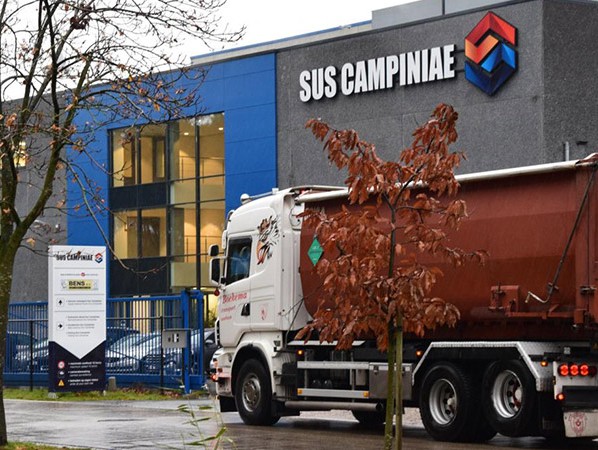
Belgian pig farming will suffer when Flemish Minister of Environment, Nature and Agriculture Joke Schauvliege (CD&V) refuses to grant a new permit to nv De Lokery, which operates the Sus Campiniae slaughterhouse in Oevel. The brand new slaughterhouse accounts for 20% of the total slaughter capacity for pigs in Belgium. That's what sales director Raf Claerhout of VandenAvenne-Ooigem says.
A tricky point is that the slaughterhouse is located 20 metres from a cemetery. The odour nuisance and the nuisance caused by transport endanger the serenity of the cemetery and are not compatible with the functions that a cemetery is supposed to perform, is the opinion of the cabinet of Minister Schauvliege.
The province of Antwerp approved the environmental permit for the slaughterhouse in early 2015, despite hundreds of objections and two petitions. On appeal, Minister Schauvliege granted the necessary permit later in 2015. The slaughterhouse was festively opened on 2 September 2017 by European Commissioner Phil Hogan. On 29 March this year, the Council of State annulled the permit and asked the Minister to provide better justification for the granting of the permit because insufficient account had been taken of "the intrinsic characteristics of the cemetery" and the resulting restrictions in terms of odour and noise nuisance.
With the annulment of the permit by the Council of States, the Minister regained control of the dossier. Although she received favourable advice from the Agency for Roads and Traffic, twice from the Environment Department (space and environment), twice from the Flemish Environment Agency (ecological supervision and water management) and from the regional environmental permit committee, Minister Schauvliege has now decided not to grant a permit. "The odour nuisance and other nuisance caused by transports endanger the serenity of the cemetery and are not compatible with the functions that a cemetery has to fulfil", it sounds.
Sus Campiniae is a collaboration between the Noordvlees Van Gool group and the Vanden Avenne group. The construction costs were approximately €35 million.
Claerhout emphasizes that Sus Campiniae has not yet received an official letter from the minister or her department. "The news came to us via the media, via a film crew that wanted to come and shoot images". According to Claerhout, closing the slaughterhouse would be a slap in the face for a pig farm that is already suffering greatly anyway. Because of the discovery of African swine fever in wild boar in the province of Luxembourg, prices for pigs are under pressure.
"In addition, this slaughterhouse is not only the largest in Belgium, but it is also at the top in terms of animal friendliness, quality and efficiency. The news of the possible closure arouses emotions: a petition against the closure was signed by 600 people.
The slaughterhouse is located in an industrial zone between the E313 motorway and the Albert canal. It is also right next to the Bens cutting plant (part of Vanden Avenne, which, like Noordvlees Van Gool, buys a large proportion of the carcasses. The slaughterhouse can slaughter and deliver 720 pigs per hour (40,000 per week, 2 million per year) for further processing. The slaughterhouse meets the requirements of the Beter Leven quality mark, which was set up in part by the Dutch Society for the Prevention of Cruelty to Animals.
As far as animal welfare is concerned, a resting area for almost 2,000 animals has been provided, with water spray to create tranquillity. The animals are anesthetized with a CO2 gas anesthesia system. The 'paternoster system' consists of six rotating cages, with one loading bay, where animals are brought down, stunned and brought up again in groups in a kind of 'Ferris wheel'.
With regard to determining the quality of meat, the so-called AutoFom system is used to pay farmers. Through ultrasonic sound waves, the entire carcass - with thousands of measurements - is shown in detail at a depth of 15 cm. This provides reliable information on the most important cuts. A rapid cooling system brings the red organs below three degrees in three hours, important for the export of the fifth quarter of an hour.
Source: © Landbouwleven